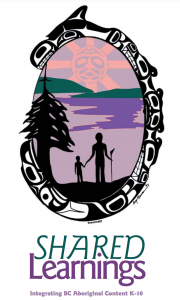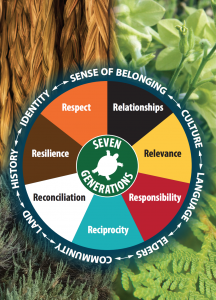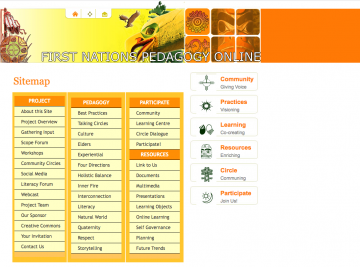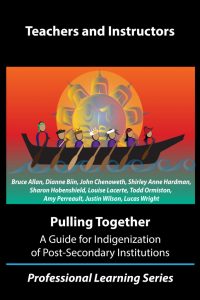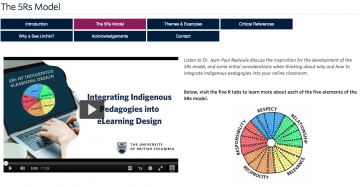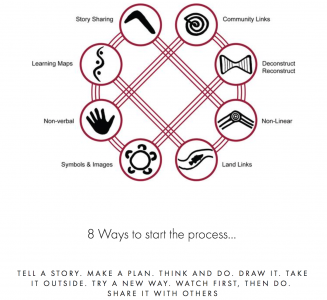A curriculum focusing on Indigenization can lead to an enlightened discussion of First Nation issues and give Indigenous students a sense of place and belonging in the school system. To support this aim of decolonizing learning and Indigenizing teaching, the curriculum requires much more than just adding Indigenous content. Since the imposition of the Western education system in Turtle Island, we have mostly learned and prioritized settler ways of learning. Decolonizing and Indigenizing the curriculum requires us to bring Indigenous ways of thinking, being and doing into course design in a holistic way. This week in the mentoring circle, we feature 8 remarkable Indigenous education digital resources, from toolkits and reports to guides and frameworks, these resources will help us take action to integrate Indigenous worldviews into curriculum development and how these can be interwoven into curriculum design and our everyday classroom practices.

1. Shared Learnings: Integrating BC Aboriginal Content K-10
Shared Learnings: Integrating BC Aboriginal Content K-10 focuses on the diversity, depth, and integrity of the cultures of British Columbia Aboriginal peoples. It is a guide for teachers, developed in recognition of the need for classroom materials that can help all teachers provide students with knowledge of, and opportunities to share experiences with, BC Aboriginal peoples. Integration of authentic Indigenous content into the British Columbia K-10 curriculum with the support of Indigenous peoples will help to promote understanding of BC First Nations among all students. To help teachers bring this knowledge into the classroom in an accurate way, and that reflects the Indigenous concept of teaching and learning, Shared Learnings: Integrating BC Aboriginal Content K-10 has been written and designed to include the support and participation of Indigenous teachers, Elders, and other knowledgeable members of each school or district’s local Indigenous community(ies).
2. The Aboriginal Lens: Education for Reconciliation – BCTF
The Aboriginal Lens is a guide for those who work in education and are committed to taking up the “Calls to Action on Education” as stipulated by the Truth and Reconciliation Commission. This framework is designed to help educators challenge the current, established systems of belief that support Eurocentric practices that have silenced other ways of knowing and being. The lens focuses our efforts and can be used to examine and assess policies and practices. The framework also works to address the needs of the collective and the community, as well as providing a common reference for teachers.
3. It’s Our Time: The AFN Education Toolkit
The Assembly of First Nations has developed the It’s Our Time First Nations Tool Kit as the basis of a comprehensive strategy to reach out to First Nations students, teachers, schools, communities and the Canadian public at large. The resource is designed to bring together First Nations and non-First Nations people and foster a spirit of cooperation, understanding, and action.to promote and enhance First Nations student success by preparing and collecting relevant resources for schools, teachers, facilitators, and other community stakeholders. The school-based aspects of the resource complement both First Nations and provincial curricula and offer a teacher-friendly resource that can be used in creative and flexible ways. It’s time for all students to learn about our First Nations history and culture. It’s time to support all teachers with classroom resources created to help students learn about residential schools and treaties. It’s time to share First Nations stories, traditions, and teachings. It’s time to explore the Assembly of First Nations’ Digital Education Toolkit.
4. First Nations Pedagogy Online
This site is the culmination of a project initiated by two education experts, Sylvia Currie and June Kaminski to create an online resource that builds on research, consultation, and community-based activities. This site provides best practices and support for online learning initiatives that are intended for Indigenous students, Elders, educators, curriculum developers, and educational leaders. This site forefronts content on self-governance and Indigenous systems of formal education before colonization. This site focuses on how to advocate for self-governance in education as several processes need to be put into place, including sustainable funding, the preparation of Indigenous educational leaders, and the development of educational systems that meet the needs of each community. With this site, instructors will have access to professional development resources that will enhance their knowledge about First Nations pedagogy and have an understanding of how to design curriculum that considers the needs of Indigenous learners.
A set of professional learning guides that are a result of a collaboration between BCcampus, the Ministry of Advanced Education, Skills and Training, and a Steering Committee of Indigenous education leaders. The content in these guides is authored by teams of Indigenous and ally writers across B.C. The guides are living resources that can be adapted and localized, offering instruction and best practices that the post-secondary institutions of B.C. can use to Indigenize their institutions. The resources are intended to augment the existing training currently offered through the institutions, recognizing that place-based Indigenous knowledges, languages, and practices are reflected in the localized delivery of Indigenized learning resources.
6. 100 ways to Indigenize and decolonize academic programs and courses by Dr. Shauneen Pete
A pragmatic article by Dr. Shauneen Pete from Little Pine First Nation teaches 100 ways to Indigenize and decolonize academic programs and courses. Indigenization is understood as “The transformation of the existing academy by including Indigenous knowledges, voices, critiques, scholars, students and materials as well as the establishment of physical and epistemic spaces that facilitate the ethical stewardship of a plurality of Indigenous knowledges and practices so thoroughly as to constitute an essential element of the university. It is not limited to Indigenous people, but encompasses all students and faculty, for the benefit of our academic integrity and our social viability” (Indigenous Advisory Circle, University of Regina). For more information listen to Dr. Shauneen Pete in the video below talk about how decolonization and Indigenization look like in the Classroom.
7. Integrating Indigenous Pedagogies into Online Learning
Indigenous educators have drawn on case studies of online learning development projects to develop the ‘Five Rs’ model to guide the integration of principles of Indigenous pedagogy in online learning. This web-based resource guides you through the elements of the 5Rs model, and offers you ideas, themes, resources and example activities that you can include in the design of your online courses. Their resources offer you insights and suggestions from Indigenous and non-Indigenous colleagues engaged in this work. In the site, they discuss the inspiration for the development of the 5Rs model using a sea urchin, and some initial considerations when thinking about why and how to integrate this model into your classroom. Native to coastal waters in British Columbia and around the world, sea urchins are an integral part of marine ecosystems. Like all other organisms in the Echinoderm family, sea urchins have five-fold symmetry, offering a useful framework for exploring the 5Rs model for incorporating Indigenous epistemologies and pedagogies into online learning design.
Teachers can incorporate Indigenous pedagogy into the classroom with the 8 Ways framework. A research project conducted by Tyson Yunkaporta (2007-2009) developed this 8 Aboriginal Ways of Learning framework. It argues that 8 interconnected pedagogies allow teachers to engage with Aboriginal learning processes while finding common ground between Indigenous and mainstream pedagogies. This framework addresses the issue of how teachers can use Indigenous pedagogy authentically and productively in the classroom. A framework designed and maintained by the Western New South Wales Regional Aboriginal Education Team and James Cook University in Australia. It is a pedagogical framework for teachers to be able to teach Aboriginal students in a meaningful way. Their website includes wonderful resources with examples of how other teachers are using the framework in their curriculum design.
